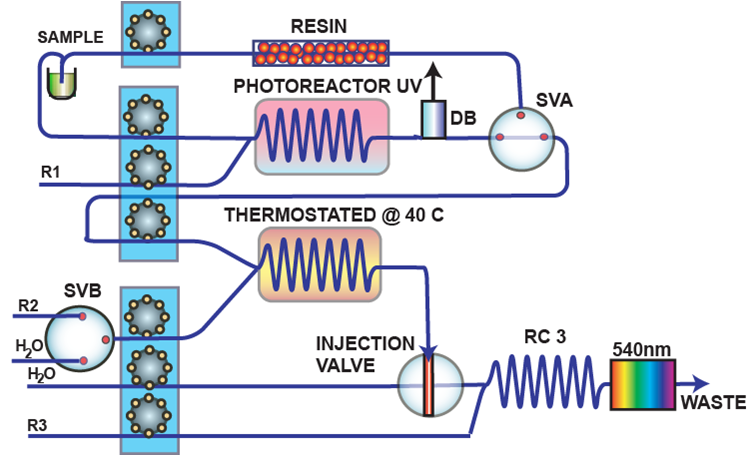On Line Sample Digestion
Speciation of nitrogen in wastewater (Cerdá 1996) is an example of a multi-stream FI system, for analysis of a complex material, using UV-assisted decomposition of organic nitrogen compounds. In this pioneering work nitrate is reduced at elevated temperature to nitrite by hydrazine in the second reactor coil, and after reaction with sulfanilamide in the third reactor coil is quantified by spectro-photometry. By directing the
1.3.7.

sample either through the photoreactor, or bypassing it (top), the total N or inorganic N has been determined.
UV irradiation and microwave digestion on-line, for analysis of organic and inorganic compounds, have been comprehensively reviewed (Cerdá 2008). Note, however, while the on-line digestion by FI is feasible, its Achilles Heel is the short time available for sample decomposition, since the material moves continuously through the photoreactor. While 30 seconds may be sufficient for the digestion of many compounds, at lower concentrations, this approach yields low results for more stable species. Thus polyphosphates cannot be digested at all in continuous flow mode (Lähdesmäki 2009). The use of stop flow SI to prolong decomposition time may have resolved resolve some of these situations (Cerdá 2003). In future, the use of flow programming in pFI mode cold turn be a novel and promising approach for solving this difficult problem.
I. Lähdesmäki, Private Communication 2009. Cerdá V. Estela J.M.: On line Sample Pretreatment: Dissolution and Digestion.” in “Advances in Flow Injection Analysis and Related Techniques. S.D.Kolev and I.D. McKelvie. Ed. Elsevier 2008.
M.T. Oms, A. Cerda`, V. Cerda Talanta 59 , 319 (2003)









